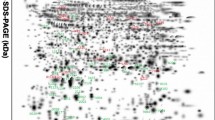Abstract
In order to explore the presence of, and the potential role of, secretagogin in human pituitary adenomas, an analytical strategy that integrated comparative proteomics and comparative transcriptomics was used to detect the protein and the mRNA expression, respectively, of secretagogin in human non-functional pituitary adenomas compared to controls. Proteomics methods included two-dimensional gel electrophoresis, 2D gel image analysis, mass spectrometry [matrix-assisted laser desorption/ionization-time of flight-peptide mass fingerprinting (MALDI-TOF PMF) and liquid chromatography-electrospray ionization-quadrupole-ion trap tandem mass spectrometry (LC-ESI-Q-IT MS/MS)], and database analysis. Transcriptomics methods included the GeneChip microarray, image processing, and data analysis. The proteomics and transcriptomics data demonstrated that secretagogin was significantly down-regulated at the protein and mRNA levels, respectively, in the human non-functional (NF) pituitary adenomas (NF−, LH+, FSH+, and FSH+ + LH+). For the secretagogin protein, the expression level was NF− < FSH+ + LH+ < FSH+ < LH+ < Control, with a range of down-regulation of 2.2–6.9 fold in non-functional pituitary adenomas compared to controls, with a significant difference (p < 0.001). For secretagogin mRNA, the expression level was NF− < LH+ < FSH+ + LH+ < FSH+ < Control, with a range of down-regulation of 1.8–18.6 fold in non-functional pituitary adenomas compared to controls that was significant (p < 0.05). The secretagogin protein expression correlated significantly with its mRNA expression. Those results suggest that secretagogin might play a role in human non-functional pituitary adenomas. This novel finding may provide clues to clarify the basic molecular mechanisms of pituitary adenoma formation, and to identify new tumor-related markers.
Similar content being viewed by others
References
Wagner L, Oliyarnyk O, Gartner W, Nowotny P, Groeger M, Kaserer K, Waldhausl W, Pasternack MS. Cloning and expression of secretagogin, a novel neuroendocrine-and pancreatic islet of Langerhans-specific Ca2+-binding protein. J Biol Chem 2000;275:24740–24751.
Gartner W, Lang W, Leutmetzer F, Domanovits H, Waldhausl W, Wagner L. Cerebral expression and serum detectability of secretagogin, a recently cloned EF-hand Ca2+-binding protein. Cereb Cortex 2001;11:1161–1169.
Desiderio DM, Kusmierz JJ, Zhu X, Dass C, Hilton D, Robertson JT, Sacks HS. Mass spectrometric analysis of opioid and tachykinin neuropeptides in non-secreting and ACTH-secreting human pituitary adenomas. Biol Mass Spectrom 1993;22:89–97.
Zhu X, Desiderio DM. Methionine enkephalin-like immunoreactivity, substance P-like immunoreactivity and betaendorphin-like immunoreactivity post-mortem stability in rat pituitary. J Chromatogr 1993;616:175–187.
Zhu X, Desiderio DM. Effects of space flight stress on proopiomelanocortin, proenkephalin A, and tachykinin neuropeptidergic systems in the rat posterior pituitary. Life Sci 1994;55:347–350.
Zhu X, Robertson JT, Sacks HS, Dohan Jr FC, Tseng JL, Desiderio DM. Opioid and tachykinin neuropeptides in prolactin-secreting human pituitary adenomas. Peptides 1995;16:1097–1107.
Desiderio DM. Mass spectrometric analysis of neuropeptidergic systems in the human pituitary and cerebrospinal fluid. J Chromatogr B Biomed Sci Appl 1999;731:3–22.
Desiderio DM, Zhan X. The human pituitary proteomics: The characterization of differentially expressed proteins in an adenoma compared to a control. Cell Mol Biol 2003;49:689–712.
Zhan X, Desiderio DM. A reference map of a human pituitary adenoma proteome. Proteomics 2003;3:699–713.
Zhan X, Desiderio DM. Differences in the spatial and quantitative reproducibility between two second-dimensional gel electrophoresis systems. Electrophoresis 2003;24:1834–1846.
Zhan X, Desiderio DM. Spot volume vs. amount of protein loaded onto a gel: A detailed, statistical comparison of two gel electrophoresis systems. Electrophoresis 2003;24:1818–1833.
Zhan X, Desiderio DM. Heterogeneity analysis of the human pituitary proteome. Clinical Chemistry 2003;49:1740–1751.
Peng J, Gygi SP. Proteomics: The move to mixtures. J Mass Spectrom 2001;36:1083–1091.
Beranova-Giorgianni S, Giorgianni F, Desiderio DM. Analysis of the proteome in the human pituitary. Proteomics 2002;2:534–542.
Gharahdaghi F, Weinberg CR, Meagher DA, Imai BS, Mische SM. Mass spectrometric identification of proteins from silverstained polyacrylamide gel: A method for the removal of silver ions to enhance sensitivity. Electrophoresis 1999;20:601–605.
Evans CO, Young AN, Brown MR, Brat DJ, Parks JS, Neish AS, Oyesiku NM. Novel patterns of gene expression in pituitary adenomas identified by complementary deoxyribonucleic acid microarrays and quantitative reverse transcription-polymerase chain reaction. J Clin Endocrinol Metab 2001;86:3097–3107.
Gorg A, Obermaier C, Boguth G, Harder A, Scheibe B, Wildgruber R. The current state of two-dimensional electrophoresis with immobilized pH gradients. Electrophoresis 2000;21:1037–1053.
Gobom J, Mueller M, Egelhofer V, Theiss D, Lehrach H, Nordhoff E. A calibration method that simplifies and improves accurate determination of peptide molecular masses by MALDI-TOF MS. Anal Chem 2002;74:3915–3923.
Poutanen M, Salusjarvi L, Ruohonen L, Penttila M, Kalkkinen N. Use of matrix-assisted laser desorption/ionization time-of-flight mass mapping and nanospray liquid chromatography/ electrospray ionization tandem mass spectrometry sequence tag analysis for high sensitivity identification of yeast proteins separated by two-dimensional gel electrophoresis. Rapid Commun Mass Spectrom 2001;15:1685–1692.
Aebersold R, Mann M. Mass Spectrometry-based proteomics. Nature 2003;422:198–207.
Hanash SM, Bobek MP, Richman DS, Williams T, Rouillard JM, Kuick R, Puravs E. Integrating cancer genomics and proteomics in the post-genome era. Proteomics 2002;2:69–75.
Author information
Authors and Affiliations
Rights and permissions
About this article
Cite this article
Zhan, X., Evans, CO., Oyesiku, N.M. et al. Proteomics and Transcriptomics Analyses of Secretagogin Down-Regulation in Human Non-Functional Pituitary Adenomas. Pituitary 6, 189–202 (2003). https://doi.org/10.1023/B:PITU.0000023426.99808.40
Issue Date:
DOI: https://doi.org/10.1023/B:PITU.0000023426.99808.40




